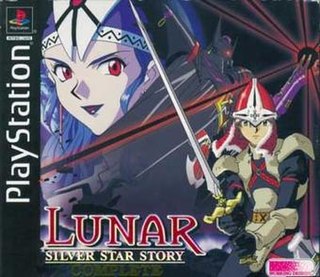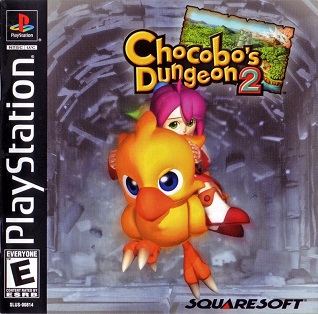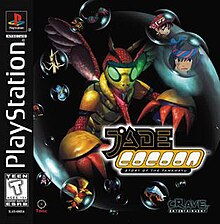
Lunar: Silver Star Story Complete, originally released in Japan as simply Lunar: Silver Star Story, is a role-playing video game developed by Game Arts and Japan Art Media and published by Kadokawa Shoten. It is a remake of 1992's Lunar: The Silver Star. While the overall plot remains true to the original, accommodations are made to the game's story to allow for a larger, richer cast, as well as additional scenarios.

Monster Rancher, known in Japan as Monster Farm, is a Japanese anime television series based on Tecmo's Monster Rancher video game franchise. It originally aired on CBC in Japan for two seasons from April 1999 to September 2000. In North America, the series was first licensed by BKN, Inc. and broadcast with an English dub on the Bohbot Kids Network, the Sci-Fi Channel, the Fox Family Channel, and Fox Kids in the United States and YTV in Canada. It was later licensed by Discotek Media in 2013.

Final Fantasy XIII is a 2009 role-playing video game developed and published by Square Enix for the PlayStation 3 and Xbox 360 consoles and later for Windows. Released in Japan in December 2009 and international in March 2010, it is the thirteenth title in the mainline Final Fantasy series. The game includes fast-paced combat, a new system for the series for determining which abilities are developed for the characters called "Crystarium", and a customizable "Paradigm" system to control which abilities are used by the characters. Final Fantasy XIII includes elements from the previous games in the series, such as summoned monsters, chocobos, and airships.

The PocketStation is a memory card peripheral by Sony Interactive Entertainment for the PlayStation home video game console. It was released in Japan in 1999. The device acted not only as a memory card, but was interactive itself via a small monochrome LCD display and buttons on its case. Many PlayStation games included software that could be downloaded and played on the PocketStation. A release in Europe and North America was planned, but was ultimately canceled. The PocketStation shares similarities with Sega's VMU for the Dreamcast.

The Misadventures of Tron Bonne is a 1999 action-adventure game developed and published by Capcom for the PlayStation. Released in Japan in 1999 and in North America and Europe in 2000, the game is part of the Mega Man Legends series. It is also a prequel and spin-off of the first Legends game.

Azure Dreams is a roguelike role-playing video game developed by Konami Computer Entertainment Tokyo and published by Konami for the PlayStation. A Game Boy Color game with the same name was developed by Konami Computer Entertainment Nagoya and released two years later. A spiritual sequel, Tao's Adventure: Curse of the Demon Seal, was released on the Nintendo DS in 2005.

Monster Rancher 2, known in Japan as Monster Farm 2, is a life simulation role-playing video game developed and published by Tecmo for the PlayStation. It is the second installment in the Monster Rancher series. It is the first game in the franchise to be released in Europe and PAL region, where it was published in October 2000 under the name Monster Rancher.

Jackie Chan Adventures is a video game based upon the animated series of the same name, which focuses on a fictionalized version of Hong Kong action film star Jackie Chan. The Game Boy Advance game, entitled Jackie Chan Adventures: Legend of the Dark Hand, was developed by Torus Games, published by Activision, and released in 2001. The PlayStation 2 version was developed by Atomic Planet Entertainment, published by Sony Pictures Television's sister company, Sony Computer Entertainment, and released on October 1, 2004, in Europe. An Xbox version was also announced but was never released. The latter console version is compatible with the EyeToy. Jackie, Jade, Uncle, Valmont and Shendu were voiced by their original actors.

Harvest Moon: Back to Nature, known in Japan as Bokujō Monogatari Harvest Moon, is a video game in the farm simulation series Story of Seasons, developed and published by Victor Interactive Software. It is the first Harvest Moon game for a non-Nintendo console. Characters from Harvest Moon 64 were transferred to be the characters in this game, although with new lifestyles, personalities, and relatives.

Chocobo's Dungeon 2 is the 1998 role-playing video game by Square for the PlayStation. It is the sequel to 1997's Chocobo's Mysterious Dungeon.

Jade Cocoon 2 is a role-playing video game developed by Genki exclusively for PlayStation 2. It is the sequel to Jade Cocoon: Story of the Tamamayu. The game features a full 3D polygonal world, 200 cutscenes, and full voice-overs.

Genki Co., Ltd. is a Japanese video game developer. It was founded in October 1990 by Hiroshi Hamagaki and Tomo Kimura, who left Sega to form the company. The company is best known for its racing game titles inspired by Japan's on-going underground tōge and wangan racing scene.

Folklore is a 2007 action role-playing video game developed by Game Republic and published by Sony Computer Entertainment for the PlayStation 3. Set in Ireland and the Celtic Otherworld of Irish mythology, the game follows two protagonists: a young woman named Ellen and a journalist named Keats, who work together to unravel the mysteries of the quaint village of Doolin by seeking the memories of the dead in the Netherworld.
Katsuya Kondō is a Japanese manga artist, character designer, animator and animation director. He is best known for his character design work on the Studio Ghibli films Kiki's Delivery Service and Ocean Waves, as well as the PlayStation game Jade Cocoon. His character designs are considered the epitome of the Studio Ghibli style.

Street Sk8er - known in PAL territories as Street Skater - is a skateboarding video game for the PlayStation. It was first released in Japan in 1998 under the name Street Boarders, then was licensed by Electronic Arts for distribution in 1999. It was re-released later in Japan as part of the Simple 1500 series of budget games under the name The Skateboard. It was released on the PlayStation 3 in Europe as a download via the PlayStation Store in May 2008.

Dark Cloud is an action role-playing video game developed by Level-5 and published by Sony Computer Entertainment for the PlayStation 2. Originally intended as a launch title for the system in March 2000, the game was eventually released in Japan in December 2000, in North America in May 2001, and in Europe in September. A spiritual sequel, Dark Chronicle, was released in Japan in 2002 and worldwide the following year.

Shadow Madness is a role-playing video game developed by Craveyard Studios and published by Crave Entertainment for the PlayStation. Set in the fictional world of Arkose, the player takes the role as Stinger, whose town has just been destroyed as a result a mysterious plague that is spreading quickly across the land. Stinger meets many friends and foes on his way to finding out how the chaos started and how it can be stopped. In traditional RPG fashion, gameplay consists of exploring towns and dungeons, collecting equipment and items, and interacting with non-player characters in environments featuring 3D polygonal models set on 2D pre-rendered backgrounds. Random, turn-based battles take place in fully-3D environments, where the player can execute various attacks and spells against enemies, gain experience points, and increase characters' attributes.

Ape Escape is a 1999 platform game developed and published by Sony Computer Entertainment for the PlayStation. The first game in the Ape Escape series, the game tells the story of an ape named Specter who gains enhanced intelligence and a malevolent streak through the use of an experimental helmet. Specter produces an army of apes, which he sends through time in an attempt to rewrite history. Spike, the player character, sets out to capture the apes with the aid of special gadgets.

Kileak: The DNA Imperative, known as Kileak: The Blood in Japan and Europe, is a first-person shooter video game developed by Genki and published by Sony Music Entertainment Japan for the PlayStation. Sony Computer Entertainment, SMEJ's sister company, released as a launch game for the console outside Japan. Kimitaka Matsumae, former member of the S.S.T. Band, wrote the game's soundtrack.
A monster-taming game is a subgenre of role-playing video game that most notably includes the Pokémon franchise. While Pokémon is the most recognizable example of such a game to Western audiences, the origins of the genre were in the Megami Tensei series, which involved fighting, negotiating with, and recruiting demons and other mythological beings.


















